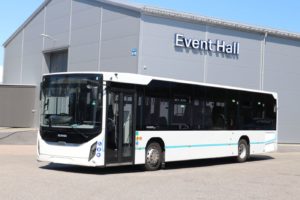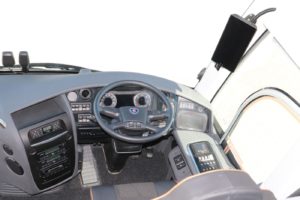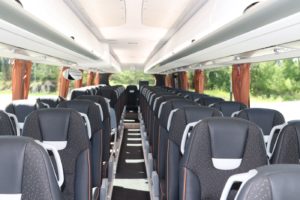Scania: the next steps
Scania’s well-loved range of chassis have had an upgrade, together with the fully-built vehicles the Sweden-based company will supply. Founding Editor Stuart Jones flew to Stockholm to see what will be coming our way
Sustainability came to the fore in Sweden last week in presentations marking the completion of the introduction of Scania’s new generation bus, coach and chassis range.
The renewal process started in 2019 when the Citywide LF was unveiled, followed by the Citywide LE and Interlink and now extending across the entire portfolio. It is not a ground-up, new range – a great deal carries over from the current generation – but Scania believes it takes another step forward towards a sustainable society.
Senior Vice President, Bus & Coach, Anna Carmo E Silva, stressed Scania’s focus on the issues of fuel economy, total operating economy and safety saying that the new generation has new safety systems built in that will limit risks and protect passengers, pedestrians and drivers as well as other road users.
The launch event combined presentations on various aspects of the issues the industry faces, Scania’s philosophy and the ways it is seeking to help operators. There were technical presentations and the chance to test drive a variety of models on the Scania test track, some of them right-hand drive examples. It also afforded the opportunity to talk to various members of Scania’s new UK team, including Mark Oliver, who took over as Sales Director, Bus, Coach and Power Solutions on 1 June. Many of the innovations announced apply only to the Citywide and revised Interlink products that are not offered in the UK and because of this I will largely ignore them and concentrate on models with UK relevance.
New features
As before, Scania’s Euro VI diesel engine family is based on familiar 7-, 9- and 13-litre units, upgraded to Step VI E with gas and hybrid versions of the 9-litre and a gas version of the 13-litre. There are also biofuel, biogas and HVO (hydrogenated vegetable oil) versions available.
Electric models have a 300kW electric motor, although Scania refer to it as ‘an electric machine’ because the motor and gearbox are combined. Although moving towards electrification, the company strongly believes electricity is not the only sustainable fuel, offering options such as HVO to make the point. It also stresses the importance of making sure that the electricity used is green electricity, produced in a sustainable manner.
Scania has signed up to some serious sustainability targets, among them reducing CO2 from its operations by 50% compared to 2015 levels, by 2025 under scope 1 & 2 and to reduce by 20% the amount of CO2 emitted by its products within the same timeframe. It has already converted all of its production plants to be carbon neutral.
Against this background it is perhaps surprising that for some markets where suitable fuel infrastructure does not yet exist, it continues to offer Euro V and even Euro III engines in its buses. Incidentally, Sweden is more than twice as successful as any other EU member at switching its transport systems to sustainable fuels. Already 95% of all public transport uses sustainable fuel and one third of the transport sector as a whole. All 2,300 regional and city buses in Stockholm have used fossil free fuel since 2018.
What’s new?
Transmissions in the new generation buses are either the Scania Opticruise in low entry and high floor models or, for city buses, the ZF EcoLife 2 fully automatic. Changes to the chassis include a front axle uprated to 8.2 tonnes and other changes reduced in an overall weight saving of up to 200kg.
Interior changes start in the driver’s area where all chassis have a completely new modular instrument panel and steering wheel which can either be supplied as a complete assembly or an incomplete one for a bodybuilder to incorporate within their own design. Both left- and righthand drive installations are the same, with appropriate side module extensions also offered. The changes are designed to provide better ergonomics, improve visibility and enhance comfort. New top-hung pedals are fitted.
The provision of active driver aids has been further enhanced beyond the automatic cruise control, while lane departure warning and AEB advanced automatic brakes are already fitted. The ACC system now maintains a constant time gap that adjusts according to the speed of the vehicle in front and the system will now slow to the vehicle to a standstill in traffic. If the vehicle in front moves within three seconds of a halt it will start to move again without input from the driver.
An additional radar-based system warning of the danger of collisions with vulnerable road users is to become mandatory in the EU on new vehicles introduced from September 2022 and all models from 2024. The Scania system uses sensors to detect vehicles in proximity travelling at between zero and 36km/h. A warning light is mounted on the A-pillar along with a vibration generator within the seat. Three levels of warning are provided; the first a yellow light, the second a flashing yellow light accompanied by a ‘haptic’ seat vibration and the third a red light and increased level of vibration. There is a similar three-level warning system covering blind spots. Two other systems, LDW (lane deviation/departure warning) with active steering and a lane-change collision prevention system both rely on clear road markings, so I wonder how these will fare with the poor state of so many of the country’s roads today?
Overall the intention is that the changes will lead to a more comfortable ride for passengers, safer driving and greater safety for other road users and lead to less accidents, less downtime and lower costs. There are other changes too, but those that are model specific are covered under the on-the-track impressions.
On the track
The Scania test facility has its own track, with roads reflecting varied terrains, plenty of bends and long sweeping stretches too. More than a dozen different models were available to try, once you had passed a breathalyser test, and though most were left-hand drive and many not available in the UK, there was plenty of relevance to UK operators.
Fencer
Launched in the UK last year, with the first example now in service with PC Coaches of Lincoln, the Fencer is a 12.2m long low-entry city bus powered by the Scania 9-litre diesel delivering 280hp (206 kW) and torque of 1400 Nm.
Extensive use of composites and GPR lessens the unladen weight. It has the ZF EcoLife 2 six-speed fully-automatic gearbox with acceleration control and two 124-litre fuel tanks. Elsewhere there are CNG-fuelled Fencers running but there are currently no plans to offer this in the UK, unless demand materialises.
A single-door bus with an offside emergency door in the centre and a manual ramp, the vehicle present was one of two built for the UK, the other having already gone to the training centre at Loughborough where technicians will be trained on its systems. Although all production vehicles will have the step E Euro VI engines, this pair have the step D version.
Equipped with the new dashboard set up which I found very easy to adjust to suit, the only hiccup with it was a sunblind that had stuck rather too low, a problem fixed in seconds immediately after my drive. Both conventional and video camera mirrors are fitted and out of habit I used the protruding ones, though the cameras were handier when parking. It pulled well and handled excellently, I had no criticisms of any aspect of this side of it.
The interior had been very tastefully specified, with seats trimmed in rich blue moquette trim with restrained orange highlights. In all there are 41 seats made up of 34 Fainsa Punts, two Fainsa Jumbos on the forward sides of the front wheelarches and five tip ups. The back row had only four seats though five is possible. Unusually there are ‘ironing board’ restraints for wheelchairs on both sides of the aisle, though the offside bay is essentially a buggy bay.
Above are 14 straphangers for standing passengers. Stanchions and screens are polished stainless steel, and there are luggage racks and additional small racks over the front wheelarches . The rear window had been blacked out, though it does not have to be. The floor rises very gently to ahead of the rear wheelarch, where there is a step up to another sloped floor section, beyond which there are a further two seats up to a somewhat cramped back row with limited headroom. If I have a reservation about the interior of the Fencer it this area which is restricted in the amount of knee-room provided.
Not everybody wants to take a 12.2m long bus and mindful of this, there is a right-hand drive 10.9m Fencer F1 in build with, for the first time, a Scania D7 engine and the option of an E-fan. This demonstrator should be in the UK in September and available for demonstration before the year end.
Scania Touring
As yet, no new-generation Scania Touring coaches have been built by Higer in right-hand drive but we were able to try a left-hand drive example.
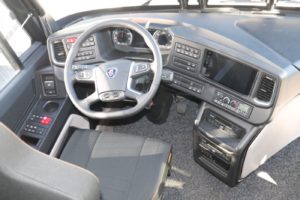
Tested in left hand drive configuration, the revised cab of the Touring HD had everything easily to hand
This 13.7m K450C B6x2*4NI tri-axle featured the 13-litre unit rated at 450hp (331kW), developed torque of 2350 Nm and used the Scania Opticruise 12-speed manual gearbox with retarder. It had 460-litre fuel tanks. In addition to the various safety systems, hill hold and the Scania Fleet Management telematics system, the driver is provided with a map reading light, an electrically operated and electrical heated driver’s window, electric sun blinds, driver’s bunk, alcohol lock, microphone and a remote control Infotainment system. A Kiel courier seat is provided.
The main internal changes to the Scania Touring range, which matches Scania chassis to coachwork built by Higer in a plant at Suzhou, China, focus on the front end; both the driver environment and a new, optional, front underrun protection system (FUP), as well as a series of enhancements to the interior using lighter coloured materials.
Though there was no right-hand drive version present, the changes are exactly the same on the left-hand drive version, with a new improved entrance step arrangement, the new dash layout and a new heated driver’s seat as standard. This is the ISRI NTS2 which is 10% lighter in weight, has an extensively adjustable three-point belt and is said to give a more stable temperature for the driver
Lee Wale, UK Retail Sales Manager, pointed out some of the other changes including a larger fridge in the dash, larger front monitor, lighter grey finishes rather than the previous fairly dark grey, and new double USB plugs on the sidecasings. The test coach was finished in bright orange and grey leather which wouldn’t have been my choice but the operator can choose what he wants. The 57 recliners fitted were a Kiel design with three-point (optionally two-point) seatbelts, optional carbon fibre finish armrests, seatback tables, footrests and armrests. The floor was finished with a wood effect.
Out on the track, the display showed 32°C and 31% humidity. Despite not yet having been PDI’d, there were no rattles. There was plenty of power when needed, driving was smooth and easy, steering was effortless (we were empty) and the braking was effective. Everything was to hand for the driver.
New generation chassis with the Higer built Touring body are currently in build and will be available from May. Both 12.1m and 13.7m variants have been ordered for stock.
FIRST DRIVE
i6S Efficient
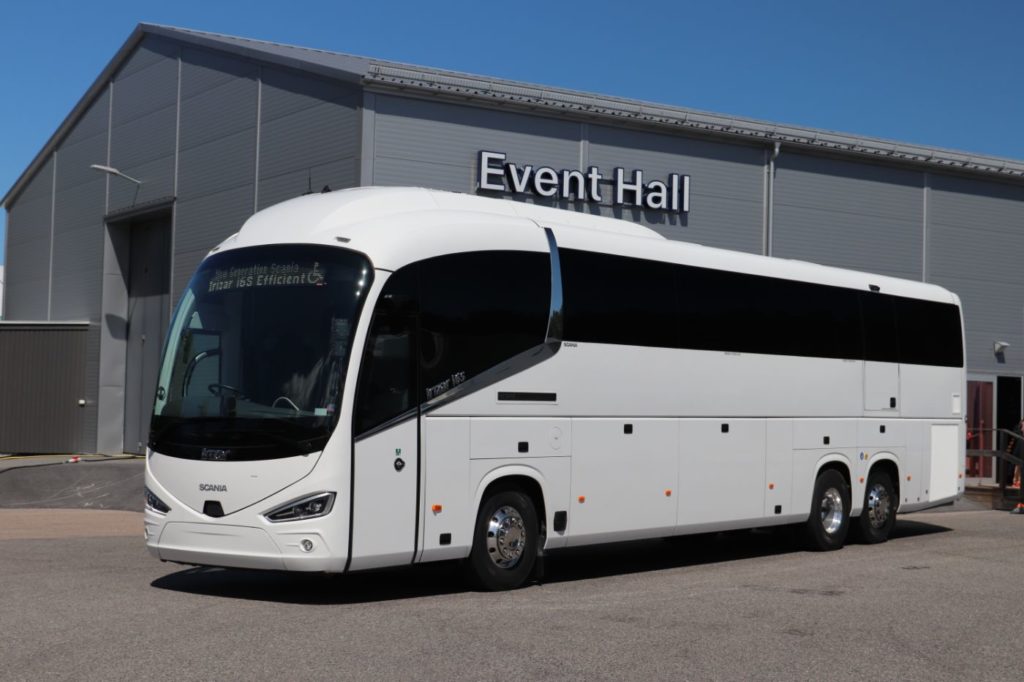
The very first right hand drive Irizar i6S is this coach mounted on a new generation Scania K450C B6x2*4NI . Built to full PSVAR specification, the sleeker looking coach offers significant fuel savings compared with similar earlier models. I am not quite used to the look without the big mirrors yet
Very much a first was an Irizar i6S Efficient on the new generation KNI410 6×2*4 chassis. Not strictly part of the demonstration line up, it was made available to the UK contingent for test drives and is the very first right-hand drive Irizar i6S Efficient built.
At 13.7m long and 3.8m high, the body is significantly lighter than a standard i6S and has a vastly improved drag coefficient that is reduced by 30%. The front is more raked, the roof has been altered, the back is less rounded to increase interior space in the rear, and the characteristic large ‘preying mantis’ wing mirrors have (optionally) been replaced with video mirrors. It is also lighter, as is the latest model Hispacold air conditioning.
The chassis specification combines the 410hp/302kW 13-litre engine which delivers 2,150Nm of torque via a Scania Opticruise 12-speed gearbox with a 567 litre fuel tank, independent front suspension and 315R80 tyres on alloy rims. The tag axle steers electro-hydraulically.
Inside, it has the new dashboard package and 59 Irizar seats with extra padding and half leather trim, which were very comfortable. Sitting in the front seat, the view is impaired by the front dome, something exacerbated by the destination equipment mounted below it, but to overcome this the monitor can show the road ahead through a forward facing camera.
The lockers have rack lockers doors which require considerable strength in order to open them – I initially thought they were locked. There were no rattles and I traced a noise I heard to a small piece of loose metal in one of the racks. The main front door is a Masats unit to a new design with a single arm. At the rear of the saloon, changes mean that more room has been created, making it more comfortable for passengers.
To the rear of the rear axle on the nearside there is a wheelchair ramp which stows away neatly. Inside the floor in this area is track for the demountable seats and the restraints.
At the wheel it was as easy to drive as every other vehicle we experienced on the day. I really liked the video mirrors which included indications showing where the rear and the axles were, so you always knew exactly where you were. Though the screen is more raked, the driver has just as much room and there is no feeling of claustrophobia.
I understand that a Swedish operator running new generation chassis with the i6s Efficient body alongside the standard i6s has reported fuel savings of as much as 17% on journeys with the new model but I have no way of corroborating this. For its part, Scania claims that it provides the best fuel economy in the market.
The Scania i6S Efficient can be ordered now with deliveries from March 2023. The 12.9m variant is the standard on two axles though 12.2m can be built to order while the three-axle options are 13.2m and 14.07m. Although this marks the official launch of the new chassis range and it will be followed by a customer event later in the year; the first new-generation chassis have already been delivered.
The very first Scania KNI410 6×2*4 went to Galleon Coaches of Stansted as part of a batch of four Irizar i8 coaches to Leger Luxuria specification delivered last week. Galleon also took a similarly bodied coach on the previous generation chassis that was ordered two years ago but not delivered in the interim because of Covid.
Other new-generation deliveries include two 80-seat Irizar i4 school coaches on 13.7m KNI360 6×2*4 chassis for Mason’s of Tring, Herts and one 12.9m two-axle KNI360 4×2 chassis for Woodstones of Kidderminster with 57 seats, although 59 seats would have been possible. Other customer vehicles are in build and new stock will be available for delivery from March 2023.
Other existing suppliers of coach bodies on Scania chassis for the UK market, including BASE, which has them equipped with MobiPeople coachwork, have received examples of new generation chassis. The Scania Interlink coach as offered in the UK for some years is to be dropped but a small number of PSVAR equipped Euro6 examples are available from stock at what I understand are attractive prices.
Battery electric bus
My last test drive of the day was in the 12.1m Citywide LF low-floor BEV, (CLF C 240E B4x2EI) a two-axle, left-hand drive example because none of the extensive list of Citywide models are offered in right-hand drive. However, an electric version of the Fencer is in the offing, of which more later.
Powered by an electric motor with a 300kW (2100Nm) peak rating and a normal rating of 250kW, it drives via a two-speed Scania gearbox and has Scania’s own battery management system. The gearbox has a direct-drive second speed with a first gear ratio of 2.59:1, usually choosing to start off in second. It has eight 33kW NMC battery packs, four at the rear and four on the roof. It is possible to increase this to ten packs, six of them on the roof. The modules or cells within each pack are currently manufactured by Samsung but the battery packs are designed and produced in house by Scania.
It was incredibly easy to drive, with a dash tailored to its propulsion system that showed when you were using energy and when you were recouping it, graded so that the rate of use/replenishment was clear. Another display showed not only how much charge remained but what that equated to in terms of remaining range.
Still to come
As well as the diesel powered Fencer F1 we saw, Scania is currently developing a BEV Fencer, and hopes to be able to demonstrate it to UK customers early next year, though deliveries would not commence until early 2024.
Based on the 12.2m Fencer, the driveline will differ from the Citywide LF BEV I drove in Södertälje in having higher-density batteries developed in a joint venture between Scania and Northvolt, in which Scania has a stake. The UK has deliberately held back to be able to take this technology which will be common with the truck range and offer support advantages.
Also set to come to the UK is the double deck Fencer F9 as promised at the original launch of the single deck Fencer, which will be suitable for city, rural and urban operations.
But not to come…
Highly unlikely to ever enter series production, but interesting anyway, were two futuristic BEV concept vehicles. One, the NXT, was quite widely exhibited a few years ago reflecting the idea of one base that could have upper structures suited to a variety of different uses. The second, more recent novelty is the PXT, designed to feature Level 5 autonomous operation, though it does have a cab area. There is a rather fanciful and fun, if somewhat impractical, interpretation of what could be offered to passengers in the interior.
Another Higer-bodied product, the high-floor Fencer F6 school coach in the ‘Car de Ligne’ tradition, has been developed specifically for the French market. It isn’t the prettiest thing they have ever built but would appear to meet the local need. CNG powered with tanks on the roof, it features 2+2 seating and a double width centre door with lift. I did not have time to travel on it.
Last word
With the development of Scania’s new generation, the company has set out what it wants to achieve and made big steps towards achieving it. 2023 to 2027 will see it further develop the modularisation policy, further extend the portfolio and launch globally, while 2028 onwards will see the completion of the electric line up and the introduction of fuel cells.
For the UK, the gaps that have been evident in the portfolio for some time are being filled, an electric isn’t far off and there’s a double decker to follow, on top of which there remains scope for other developments if the market requires them.
